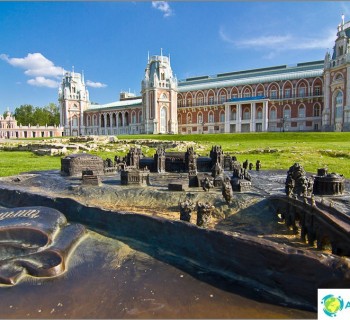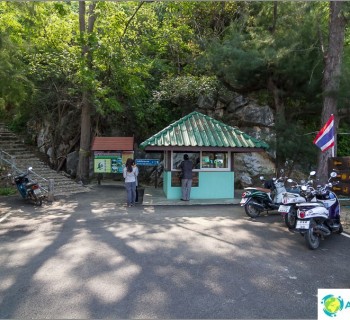In the last year, from time to time you could see photos of stars in my articles. Some asked me questions, they say, what is the aperture, what is the shutter speed, and so on. Therefore, I have already published the photos themselves in a separate post. Photos of the starry sky with their parameters, but here I want to lay out a detailed description of how to photograph the starry sky. I have long wanted to write such an article, but I had very little experience. After reading this manual, you can at least take the same photos as mine.
Immediately I warn you that I am not a pro in this matter, and you will not discover something fundamentally new for yourself, especially if you yourself are engaged in such filming. Nevertheless, it will be useful for beginners to learn some of the nuances that I did not know at one time..
The content of the article
- one All parts of my Beginner Photographers FAQ
- 2 What you need to shoot a starry sky
- 3 My set for shooting the starry sky
- 4 My typical mistakes
- five Variants of how you can shoot a starry sky
- 6 How to photograph a starry sky - static stars
- 7 How to photograph a starry sky - rotation of the sky, tracks
- eight How to photograph the starry sky - tracks in the program
- nine How to shoot timelapse
- 10 Some nuances when shooting a starry sky
All parts of my Beginner Photographers FAQ
I have written a number of photography-related articles aimed at hobbyists like me. Here is a list of them, you can read.
one. Which camera to choose for a novice photographer
2. What lens is needed for what and what to choose
3. Basic Digital Camera Settings
4. How to take travel photography
five. How to process photos in Lightroom and how to store them
6. Example of a photo bag and travel backpack
7. How to photograph the starry sky
0. What I photograph when traveling
What you need to shoot a starry sky
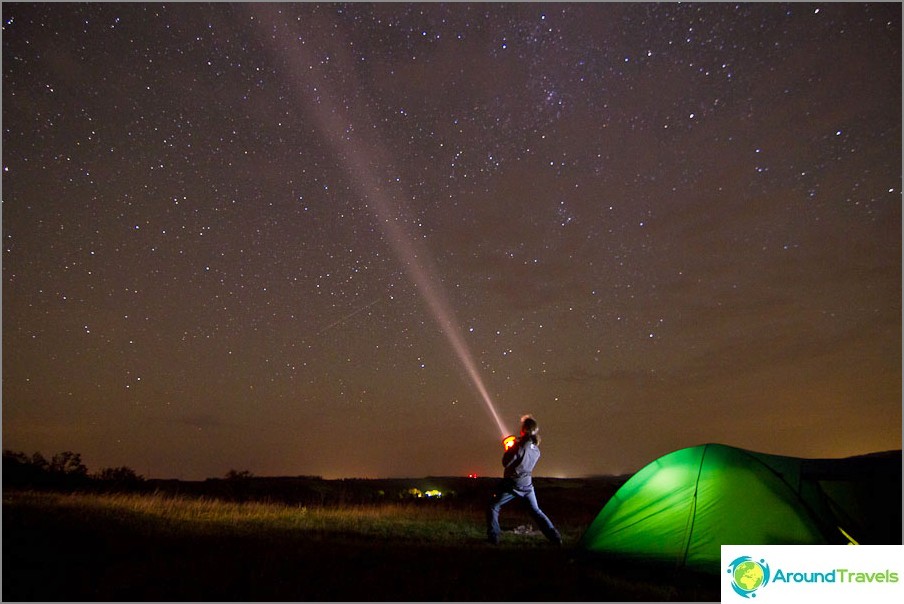
How to photograph the starry sky | ISO1600, 11mm, f2.8, 30sec
- First of all, a tripod. Exposures are long and without a tripod anywhere. It is important that it can withstand the weight of the camera along with the lens and not wobble, but it should not be too heavy, otherwise you will not want to take it on a trip, well, if you are not by car, of course..
- A camera with manual settings and preferably shooting in Raw, because this format provides great opportunities for photo processing. It would be just as good if the ISO could be set at 800-1600 without much damage to the picture..
- Wide-angle high-aperture lens for capturing static stars and a large coverage of the area of the starry sky.
- Remote control for setting long exposures, in common people - a cable.
- Spare battery, as it is consumed quickly enough.
My set for shooting the starry sky
In general, I already wrote about our set of photographic equipment with my wife in the article What we photograph. But there was the whole list, namely the pictures of the night sky I am currently doing:
- Canon 7d camera
- Wide-angle and fast lens Tokina 11-16 F2.8
- Programmable remote
- Slik Sprint Pro II 3W CG tripod
I think you can take pictures of the starry sky with a soap box, if it allows you to do some things, such as: set the shutter speed to 30 seconds or connect the remote control to it, screw on the tripod, set the ISO higher without brutal noise, open the aperture wider. Otherwise, you will be severely limited in opportunities, and it is unlikely that anything will work out..
My typical mistakes
Not so long ago I started trying to shoot the starry sky. But my first photographs did not work at all, since I was sure that just a long exposure of 30 seconds would be enough. As a rule, all DSLRs make it possible to shoot with a shutter speed of 30 seconds without a remote control..
So, for such exposures, you cannot clamp the aperture, although you want to make everything sharp. In this case, there is not enough light from the stars so that they can normally appear in the sky. On the contrary, you need to open it to the maximum! In my lens it is F2.8, some people buy even faster lenses. But not only the aperture needs to be opened, it is also desirable to set ISO at least 800-1600.
Variants of how you can shoot a starry sky
1. Shooting static stars. Exposure 10-40 sec. They look like dots, that is, the way we see them with an ordinary eye..
2. Shooting the rotation of the starry sky (stars in the form of stripes) or otherwise, tracks. Long exposure from several minutes to several hours. Completely unrealistic photos, but they look funny.
3. Shooting tracks, but in a different way. A large number of photographs of the same area of the sky are taken using the technology of shooting static stars with an interval of 1 second, and then they are glued together in a special program into one photograph. Visually, it is similar to option 2, but more colorful and with less noise. When shooting tracks according to option 3, we get both the glued final photo and the ability to rivet a timelapse video.
4. Timelapse. More photos of static stars are taken, and then combined into a video. It turns out very beautiful videos, how the stars move across the sky.
How to photograph a starry sky - static stars
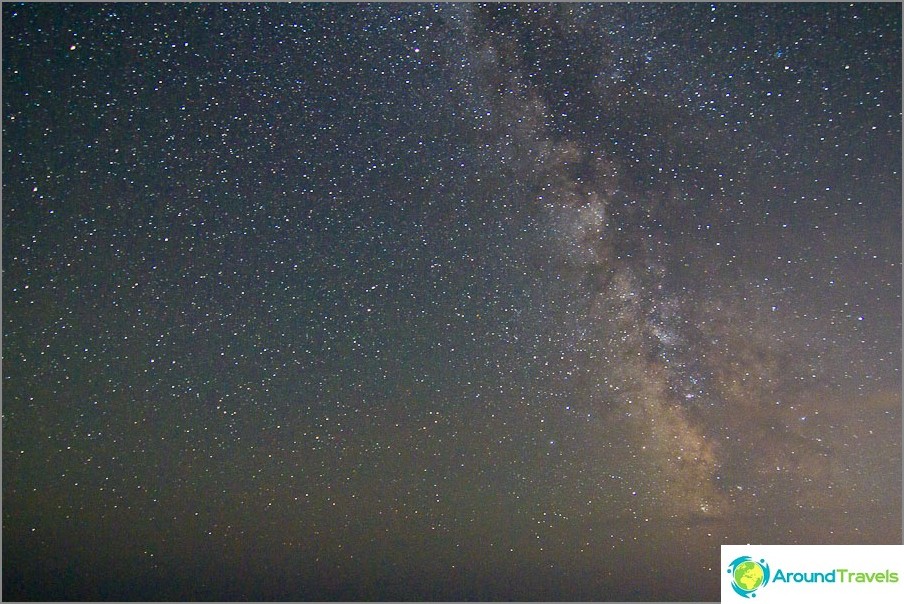
Static stars. ISO1600, 11mm, f2.8, 30sec
Excerpt
Well, let's move on to photographs and shooting directly. As you already understood, due to the fact that the stars move, they remain in the form of fixed points only until a certain exposure. And if it becomes more important, then they turn into stripes. And in order to calculate that very critical exposure value, there is a rule «600».
You need to divide 600 by the focal length of your lens and we get the maximum shutter speed at which the stars are still points. This formula is valid for full frame cameras, crop factor 1:
15 mm - 40 sec
24 mm - 25 sec
35 mm - 17 sec
50 mm - 12 sec
85 mm - 7 sec
135 mm - 4 sec
200 mm - 3 sec
300 mm - 2 sec
600 mm - 1 sec
More often than not, everyone, including myself, does not use full-frame cameras. So, we need an amendment - we also divide 600 by your crop factor. For Canon cameras this is 1.6:
10 mm - 38 sec
11 mm - 34 sec
12 mm - 32 sec
15 mm - 25 sec
16 mm - 24 sec
17 mm -22 sec
24 mm - 15 sec
35 mm - 10 sec
50 mm - 8 sec
Obviously, a full-frame sensor and wide-angle lenses have a larger shutter speed reserve. That is, shooting with a 50 mm lens on a cropped matrix, you have only 8 seconds, and this is very, very little, the stars will not be visible. In addition, such a lens may not have enough field of view..
According to my observations, the shutter speed can still be increased by one and a half times. Yes, when zooming on a computer, the stars will already be dashes, but in small photographs (for a blog, for a 10x15 print) this may not be particularly visible.
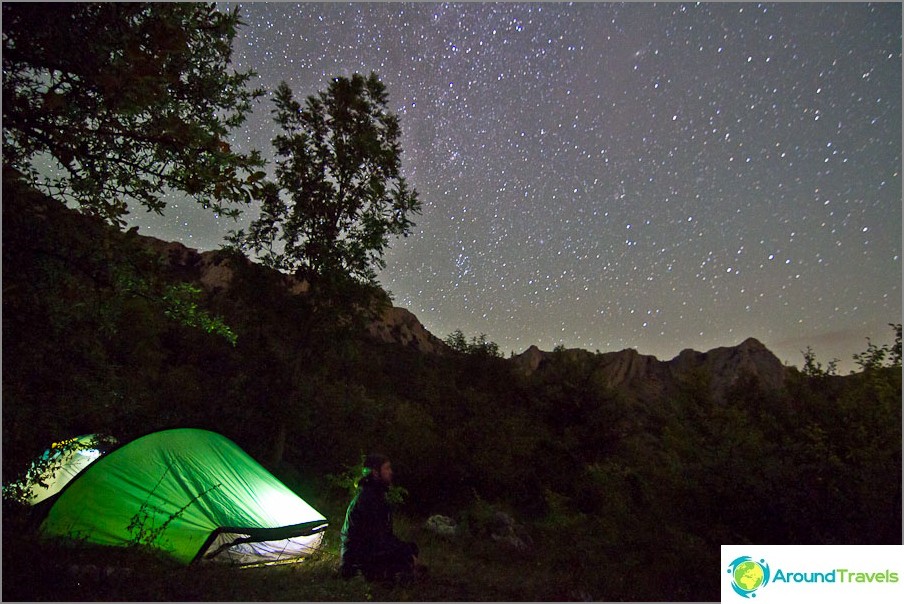
The shutter speed is longer than 34 seconds. ISO1600, 11mm, f2.8, 59sec
Diaphragm
It is best to open the diaphragm as wide as possible. If the lens allows opening at 1.6-1.8, then it will be possible not to increase the shutter speed above the critical one and ISO not to be set above 800. Sharpness drops, but what can be done.
Manual focus
At night, you can forget about automatic focus, so you have to use only manual focus. It is usually advised to put it in the extreme position at infinity, because we shoot the stars. But I was faced with the fact that my lenses almost never themselves twist the focus to infinity in the automatic mode. I checked, focusing on the moon, on distant lights (by the way, these are options for autofocusing at night). It remained quite a bit to the extreme position, and I used it in the future..
Focal length
Once again, I repeat, the longer the focal length, the shorter the shutter speed should be, because the stars are getting closer, which means that in order to prevent tracks, you need to reduce the shooting time. In addition, the viewing angle may not be enough for you, you will not just shoot one sky without everything. And the density of stars decreases as we approach.
How to photograph a starry sky - rotation of the sky, tracks
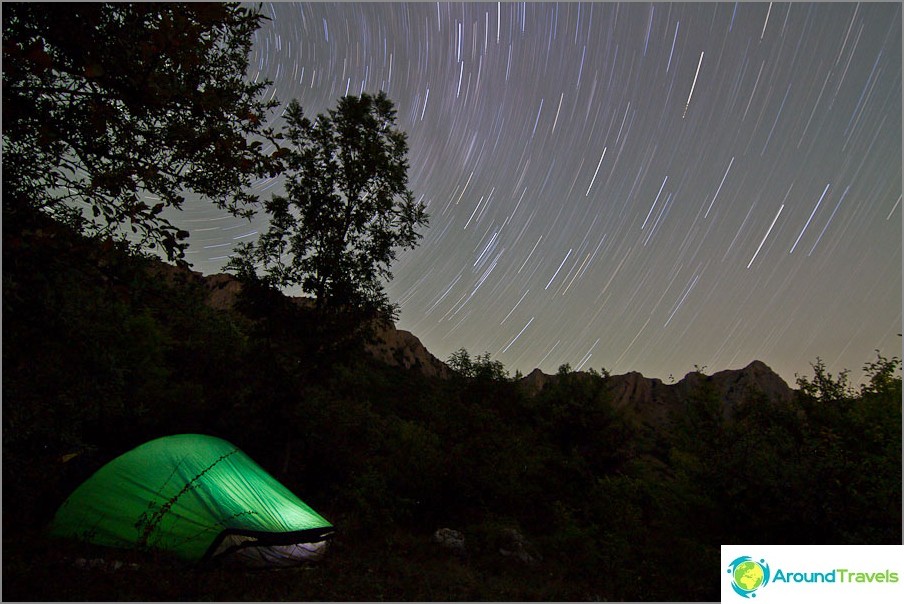
Rotation of the sky. ISO400, 11mm, f5, 1793sec
So far, I filmed tracks quite a bit and only according to the second option (without the use of additional programs).
Excerpt
From 10 minutes to several hours. The longer it is, the longer the lines drawn by the stars. It takes a remote control to set these values and a good tripod so that it doesn't get swayed by the wind for so long. Just keep in mind that at these shutter speeds it is very difficult to calculate the correct exposure..
Diaphragm
It is difficult to write specific values, since I do not know how to calculate the exposure, most likely only empirically. And there is always a risk that after half an hour of waiting, you will get an overexposed frame. I put it by eye, for example - 11 mm lens, exposure 30 minutes, aperture 7.1, ISO 400.
Focal length
In this case, it can no longer be said that it is better when it is minimal, because precious seconds of exposure are no longer so important, there will be enough light anyway, the count goes not for seconds, but for tens of minutes. Therefore, if the composition of the frame is good with a regular lens, and not with a wide-angle lens (there is enough angle), then this is even better, since you will have to wait much less for the frame to be captured. But you need to understand that the stars will be closer and their tracks will become less round. You will hardly need a lens larger than 50 mm.
Determination of the center of rotation of stars
Since the stars in the sky rotate, their tracks are circles, which, of course, have a center. And, if you build the composition of the frame in a certain way, then it will be useful to find out where this very center is. Therefore, in the northern hemisphere, we aim the lens at the North Star, and in the southern hemisphere at Sigma Octant. Rotating, in half an hour, the star forms an arc of 7.5 degrees, and this arc is the longer, the farther the star is from the Pole Star or from Sigma Octant.
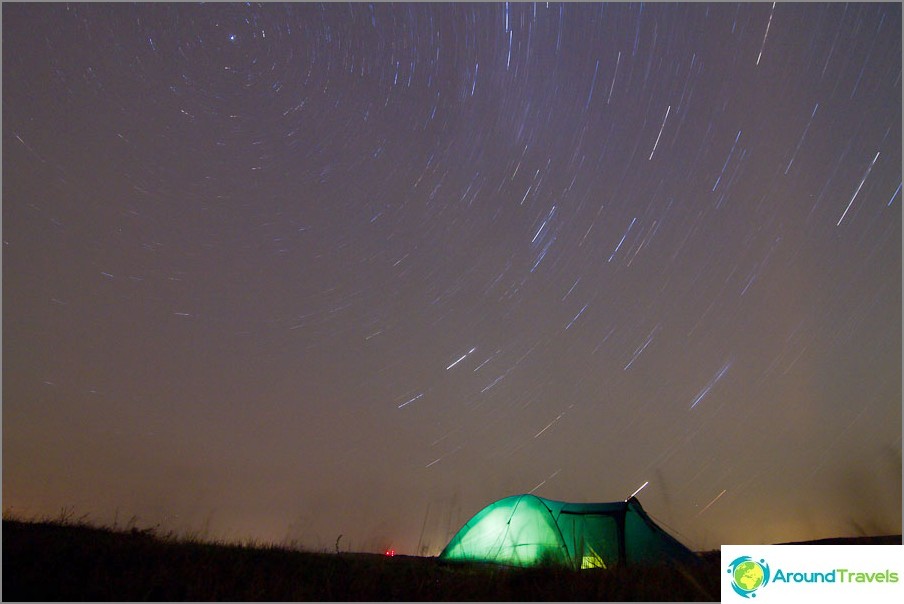
In the center of rotation is the North Star. ISO400, 11mm, f7.1, 1793sec
Now about how to find the stars we need. The easiest way to find the North Star is through the Big Dipper. We find a constellation on the horizon, mentally connect two stars of the ladle, forming one of its walls, located opposite the handle of the ladle, and we get a line. We mentally postpone 5 distances along this line from the bucket (from its top and further) and rest against the Polar Star.
Sigma Octant in the southern hemisphere, it seems to me, is almost impossible to find. It is easier to be guided by the constellation of the Southern Cross. We first find it in the sky, and then extend the long crossbar of the cross downward by 4.5 distances of this very crossbar. This is where Sigma Octant will be..
How to photograph the starry sky - tracks in the program
All settings are set in the same way as in the first step when shooting static stars. I will not repeat myself. But in fact, you can use longer exposures when you can see a little displacement of the stars. All the same, all this will be glued together into the program. But in this case, as separate photos, they will not be very beautiful, and then you cannot make timelapse..
Track gluing software
There are probably different programs, but I know only one - Startrails Version 1.1, it is very simple and easy to understand. We upload files and make tracks. If they turned out to be too long, then you can remove some of the photos from processing..
How to shoot timelapse
I did the Timelapse with the stars only once, as it is quite a long time. And then, having made 99 frames, I went out of the tent and realized that the sky was overcast, and nothing else was shining for me, it's a shame. Up to this point, I filmed only timelapse in the afternoon, as the sun sets or people move, and it was video filming on a soap box (she does it well for me), accelerated later in Premier. And to shoot the sky, you need a camera, a video camera at night will not be able to shoot with such a long exposure.
The video used 99 frames (ISO1600, 11mm, f2.8, 27 sec) at 1 second intervals. The total shooting time is 46 minutes. This was enough for 4-7 seconds of video. If you make it slower, then you will already notice how the image is interrupted..
Here's a quick calculation of how many photos you need to have for a 1-minute video with the starry sky rotating. The video contains 25 frames in 1 second, and if it is a minute, then it will already be 25 * 60 = 1500 frames. We shoot each photo, for example, with a shutter speed of 30 sec and an interval between frames of 1 sec, which means that to shoot 1500 frames we will have to spend 31 * 1500 = 46500 seconds, or 775 minutes, or ~ 13 hours.
Some nuances when shooting a starry sky
1. If the moon is shining brightly in the sky, then the stars will be faded against the blue sky. Therefore, you need to shoot before the moon rises, or at a time and place where the moon is not visible, as well as on a new moon. For example, in August in the Crimea for 5 days of the hike, I never saw her, and the sky was black and black. But in fact, lunar landscapes can be quite beautiful, the night luminary illuminates everything around very well..
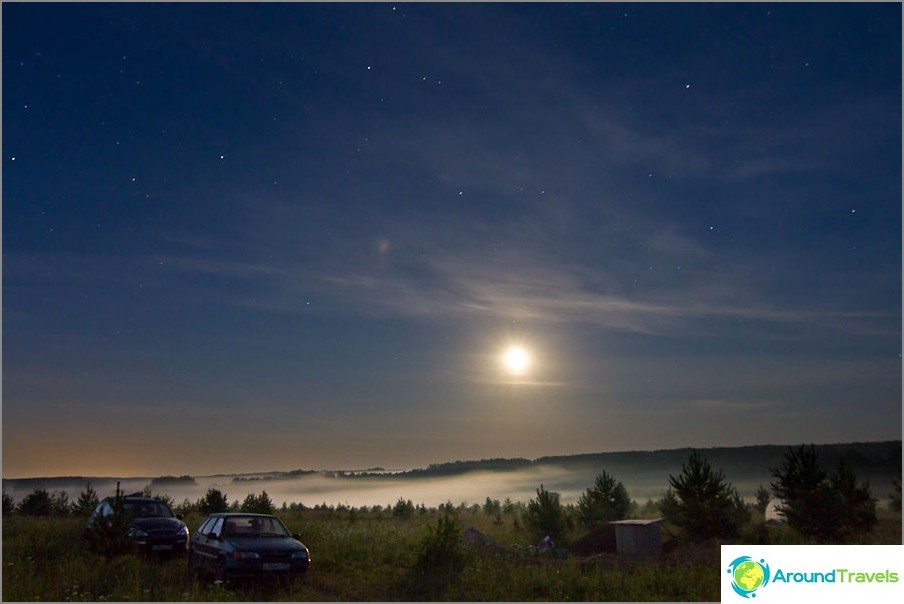
The stars are very poorly visible. ISO800, 16mm, f7.1, 30sec
2. The lights of a big city illuminate the sky just as well, and inside the city it is not realistic to shoot the starry sky at all, you need to move away for tens of kilometers. And only if the city is visible somewhere in the distance, you can get an interesting lighting..
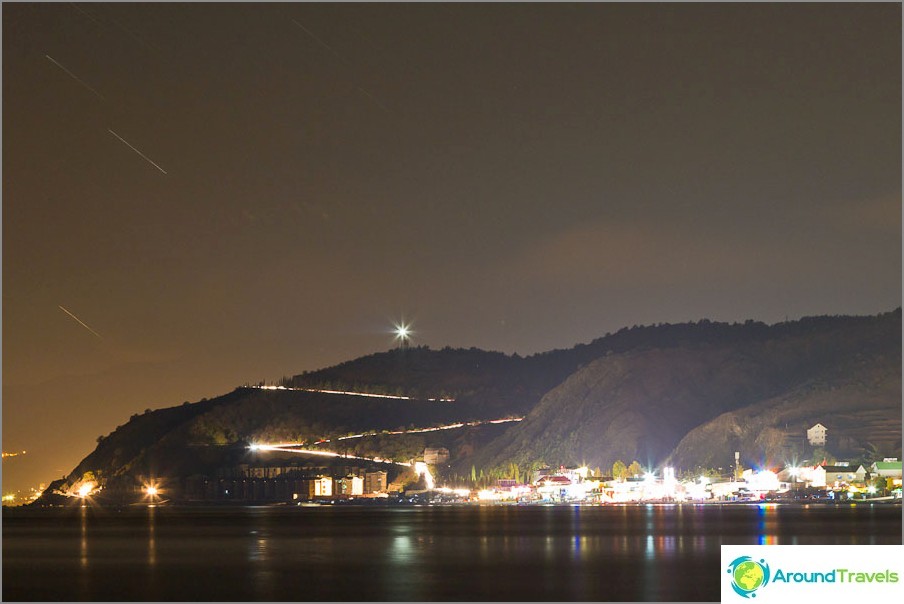
The sky lit up by the village. ISO400, 84mm, f8, 298sec
- It should be borne in mind that at night there is a possibility of fogging of the front lens. Therefore, if it is humid, then ultra-long exposures and shooting tracks are not always possible..
3. With long exposures of about ten minutes, the matrix heats up and eerie noises appear in the photo. I won't say about all DSLRs, but in my Canon 7d it is very noticeable - a lot of multi-colored dots in the photo. But the function of suppressing noise at long exposures saves, they are somehow subtracted from the image. There is only such a moment, the noise reduction works as long as the shutter speed lasted, which means that the duration of shooting one frame doubles, for example, instead of 30 minutes, a whole hour. The option of shooting tracks by gluing photos in specialized software is devoid of this drawback, the matrix does not have time to heat up.
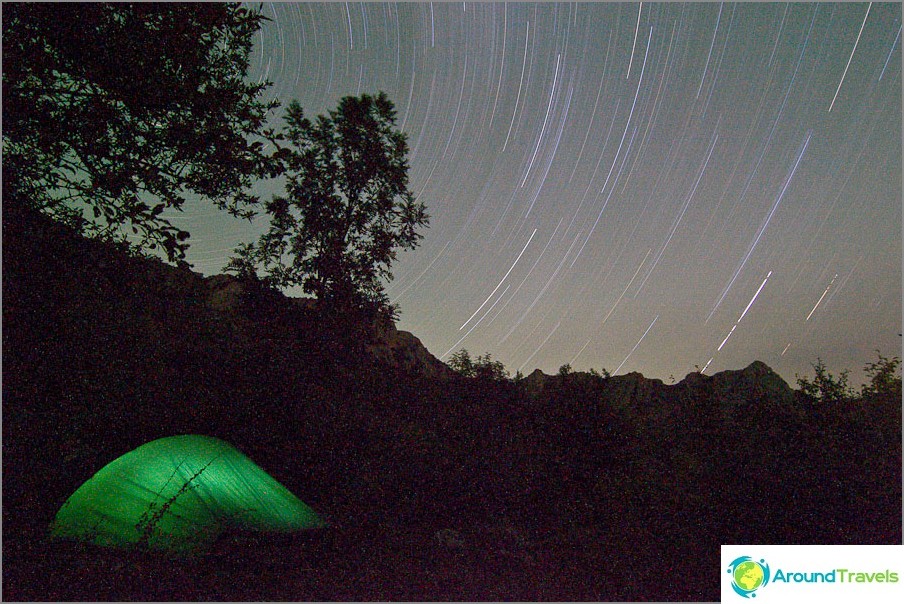
Color noise appears without built-in noise reduction. ISO400, 11mm, f8, 5381 sec
4. Just the starry sky is enough to shoot once. Next, you will want to take more interesting photos, and for them you need objects in the foreground. Therefore, the problem arises of choosing a place for shooting, an ordinary field or forest looks so-so, you need to experiment and turn on your imagination. Personally, I like the mountains most of all in this regard, but since I don't go there often, I don't have so many frames of the starry sky..
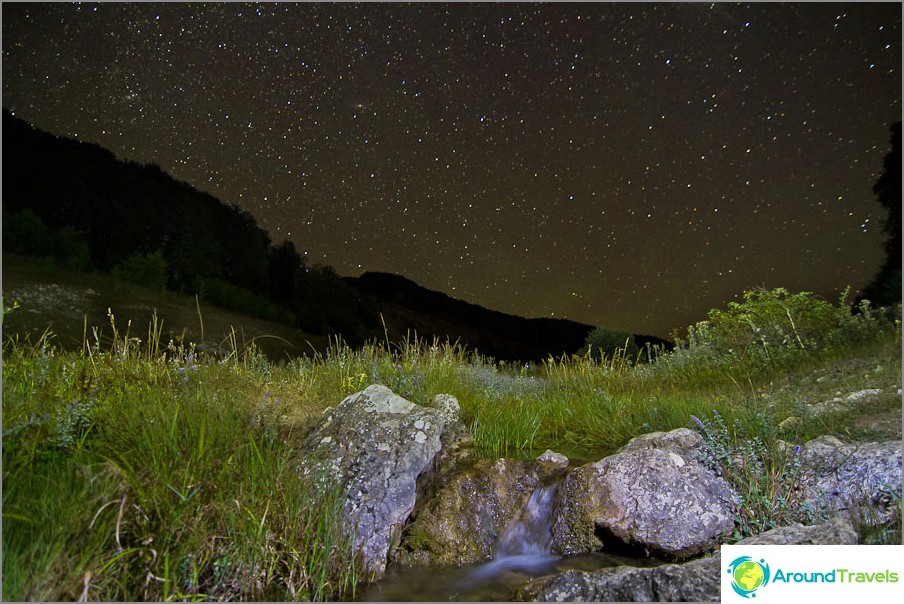
Hike across the Crimea. ISO1600, 11mm, f2.8, 30sec
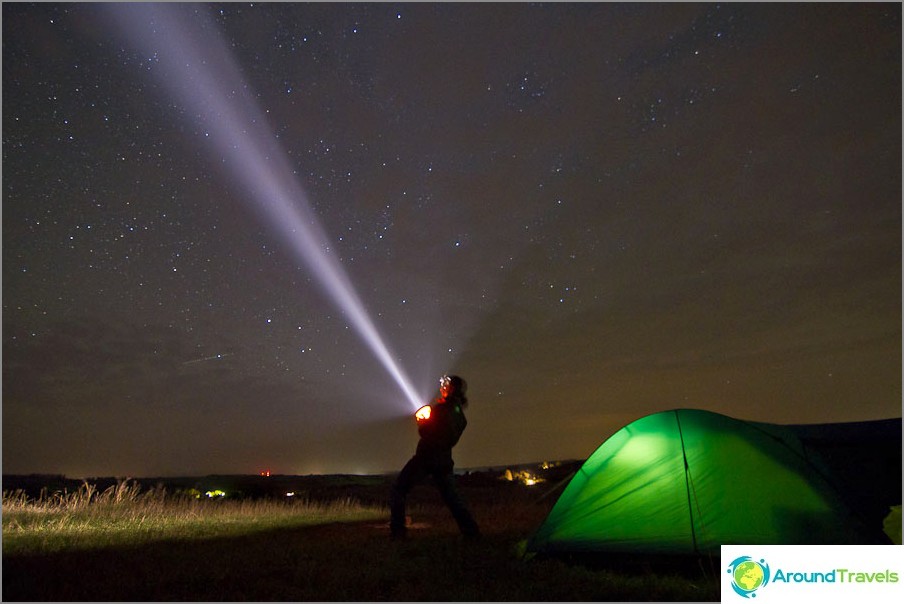
Beautiful Sword, Tula region. ISO1600, 11mm, f2.8, 30sec
